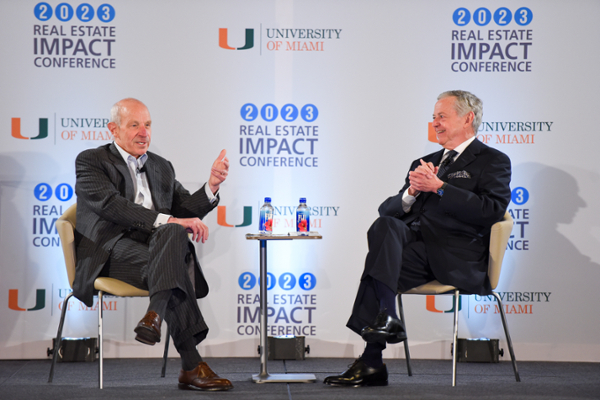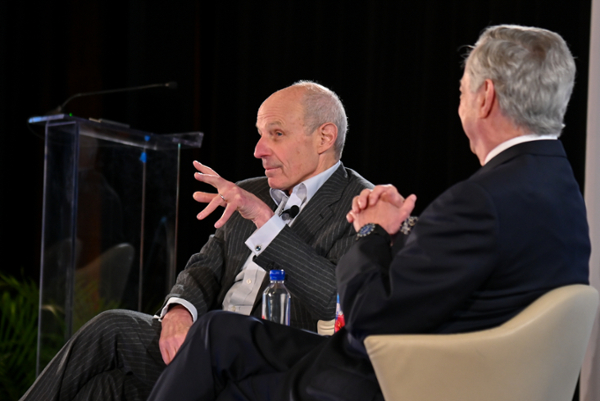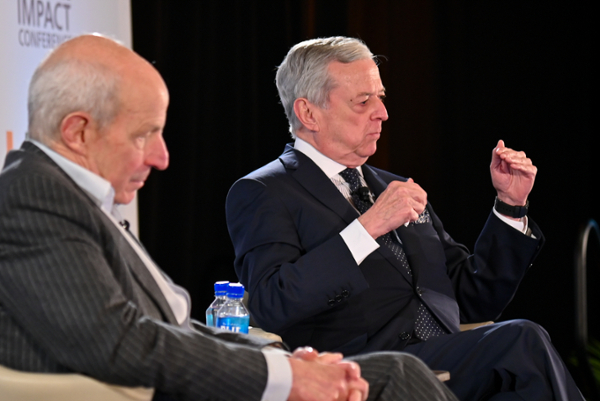Why You Can Count on South Florida Real Estate
 Every real estate project begins with a vision. Developers, government officials, hoteliers, investors, architects, designers, and sometimes the public at large see an unmet need or opportunity in the marketplace that real estate can solve. Jonathan Tisch of Loews Hotels & Co and Armando Codina of Codina Partners are no strangers to this fundamental truth, and at this year’s conference, they spoke about what it takes to successfully go from that initial idea to the delivery of a completed property.
Every real estate project begins with a vision. Developers, government officials, hoteliers, investors, architects, designers, and sometimes the public at large see an unmet need or opportunity in the marketplace that real estate can solve. Jonathan Tisch of Loews Hotels & Co and Armando Codina of Codina Partners are no strangers to this fundamental truth, and at this year’s conference, they spoke about what it takes to successfully go from that initial idea to the delivery of a completed property.
Codina began by sharing a fond memory of Tisch’s late father, Preston Robert (Bob) Tisch, who Codina credited with helping him establish himself within the Miami real estate industry in the early 1980s. At the time, the Tisch family was in the midst of transitioning their hotel portfolio in Miami, specifically the Americana in Bal Harbour, which would later become the Sheraton Bal Harbour, before being demolished to build what is now The St. Regis Bal Harbour. “I would not be here today without your father,” Codina reflected, “a very good man who made sure I got to know the right people.”
 “Fast forward a decade and I’m the one who should be thanking you,” replied Tisch. “This man is a huge reason why the Loews Miami Beach is here today,” he added to the audience in attendance. The pair then recalled the story of how the now-iconic hotel on Collins Avenue came to be. Miami Beach government had control of a 3.5-acre parcel just north of Lummus Park and Ocean Drive, with frontage along Collins Ave/A1A and 600 linear feet of direct Atlantic Ocean beachfront. It was the early 1990s, not long after Hurricane Andrew, and the city of Miami Beach wanted to enter into a public/private partnership to develop the space as a luxury hotel and resort with ample conference and event facilities to accommodate a growing tourism population. “We were the smallest company to submit a bid, for certain,” recalled Tisch. “We were up against Marriott, Hyatt, Sheraton, all the big boys. Thankfully, our time in Bal Harbour and our success with our other properties nationwide put us on a level to compete.”
“Fast forward a decade and I’m the one who should be thanking you,” replied Tisch. “This man is a huge reason why the Loews Miami Beach is here today,” he added to the audience in attendance. The pair then recalled the story of how the now-iconic hotel on Collins Avenue came to be. Miami Beach government had control of a 3.5-acre parcel just north of Lummus Park and Ocean Drive, with frontage along Collins Ave/A1A and 600 linear feet of direct Atlantic Ocean beachfront. It was the early 1990s, not long after Hurricane Andrew, and the city of Miami Beach wanted to enter into a public/private partnership to develop the space as a luxury hotel and resort with ample conference and event facilities to accommodate a growing tourism population. “We were the smallest company to submit a bid, for certain,” recalled Tisch. “We were up against Marriott, Hyatt, Sheraton, all the big boys. Thankfully, our time in Bal Harbour and our success with our other properties nationwide put us on a level to compete.”
 “You have to understand,” Codina explained to conference attendees, “This was much more than simply building a hotel. The bid had to show the ability to successfully operate and manage not only the property itself, but food & beverage, guest experiences, and more. This was to be a landmark building for the city so these were ‘must do’ considerations.” He also pointed out that there had to be a way to include the St. Moritz tower - an art deco architectural gem with a striking rounded facade and tiered upper spire. “We knew many other bidders were going to ask for variances for height, the preservation aspect, and other considerations. The recommendation here was to submit a bid that conformed to all the development authority had asked for, with no variances.”
“You have to understand,” Codina explained to conference attendees, “This was much more than simply building a hotel. The bid had to show the ability to successfully operate and manage not only the property itself, but food & beverage, guest experiences, and more. This was to be a landmark building for the city so these were ‘must do’ considerations.” He also pointed out that there had to be a way to include the St. Moritz tower - an art deco architectural gem with a striking rounded facade and tiered upper spire. “We knew many other bidders were going to ask for variances for height, the preservation aspect, and other considerations. The recommendation here was to submit a bid that conformed to all the development authority had asked for, with no variances.”
“It wasn’t a hard sell for me,” said Tisch, who knew how important art deco and historic architecture were to Miami Beach. The Americana Bal Harbour was a Morris Lapidus design from the same era as the famed Fontainebleau, further up the beach. “What we had to do was sell our vision to the selection committee.” Tisch then shared a humorous anecdote about having a memorable way to close the presentation. At the time, the Lillehammer, Norway Olympics were underway, and TV Host Dave Letterman had a recurring segment in which he would replay interviews his mother conducted with people on the street at the games. Originally, Tisch thought he’d recreate this segment with his own mother, Joan, but ended up donning a wig and dress and portraying his mother himself. Despite reservations from his father and others, the move was a hit. “I remember them saying if he’s willing to dress in drag for this pitch, then he clearly gets Miami Beach and is serious about making this happen.” Loews won the bid in a unanimous 9-0 vote.
 This led to a discussion of the latest Loews property in Miami, the Loews Coral Gables, which hosted this year’s event. The hotel is only one component of The Plaza, a massive 7+ acre mixed-use property prominently positioned along Ponce De Leon Boulevard, just a few blocks from Miracle Mile in the heart of the downtown Coral Gables business district. With 2.25 million square feet of Class A office and commercial space, luxury rental residences, ground level retail, hotel, and food & beverage offerings, entertainment, outdoor activations, and the preservation of the George Merrick Art Center Building and original office, The Plaza was the vision of the Beckmann and Cuervo families as part of the Agave Ponce development group. “Together, they saw a huge opportunity to bring group and corporate service to the area in a huge way,” remarked Tisch. “And we’re very happy to be a part of it. This was an excellent chance for Loews to expand its footprint without being in direct competition with Loews Miami Beach, while also remaining rooted in what Loews does best, which is high-end personalized hospitality.”
This led to a discussion of the latest Loews property in Miami, the Loews Coral Gables, which hosted this year’s event. The hotel is only one component of The Plaza, a massive 7+ acre mixed-use property prominently positioned along Ponce De Leon Boulevard, just a few blocks from Miracle Mile in the heart of the downtown Coral Gables business district. With 2.25 million square feet of Class A office and commercial space, luxury rental residences, ground level retail, hotel, and food & beverage offerings, entertainment, outdoor activations, and the preservation of the George Merrick Art Center Building and original office, The Plaza was the vision of the Beckmann and Cuervo families as part of the Agave Ponce development group. “Together, they saw a huge opportunity to bring group and corporate service to the area in a huge way,” remarked Tisch. “And we’re very happy to be a part of it. This was an excellent chance for Loews to expand its footprint without being in direct competition with Loews Miami Beach, while also remaining rooted in what Loews does best, which is high-end personalized hospitality.”
Codina then took the opportunity to ask Tisch the secrets behind the family’s multiple decades of successful hospitality operations, going back four generations. “You know,” Tisch responded, “it truly is all about being authentic, personable, and matching this with tremendous financial acumen.” He then shared how his own father and uncle embodied this spirit with his father, Bob Tisch being the consummate ‘front of house’ type of leader, and his uncle, Laurence, being the keen, meticulous ‘back of house’ type of leader. “We understand the value of relationships - because when you’re family you can’t just get rid of people because you disagree, you have to learn to work alongside each other. It’s a skill set that everyone benefits from. We treat the people we work with and who work for us like family, and we get their best in return. It really is that simple.”
At that point, Tisch turned the spotlight on Codina, and noted his ability to see “what’s next” for South Florida before anyone else. “I realized early,” shared Codina, “that the future of Miami wasn’t in building office buildings and skyscrapers, though of course, we have that too. The real future of Miami was, and still is, being connected to transportation… the airport, the seaport, and more within a given area. Today, if you look around, there isn’t a spot in Florida that doesn’t have tremendous potential. This is an area of the country that is doing things right… not perfect (no one can do that), but generally in the right direction. When you look at all the greater markets and submarkets, there’s room for growth across the breadth of all these spaces. It’s the relationships that will make that happen.”



 Every real estate project begins with a vision. Developers, government officials, hoteliers, investors, architects, designers, and sometimes the public at large see an unmet need or opportunity in the marketplace that real estate can solve. Jonathan Tisch of Loews Hotels & Co and Armando Codina of Codina Partners are no strangers to this fundamental truth, and at this year’s conference, they spoke about what it takes to successfully go from that initial idea to the delivery of a completed property.
Every real estate project begins with a vision. Developers, government officials, hoteliers, investors, architects, designers, and sometimes the public at large see an unmet need or opportunity in the marketplace that real estate can solve. Jonathan Tisch of Loews Hotels & Co and Armando Codina of Codina Partners are no strangers to this fundamental truth, and at this year’s conference, they spoke about what it takes to successfully go from that initial idea to the delivery of a completed property.  “Fast forward a decade and I’m the one who should be thanking you,” replied Tisch. “This man is a huge reason why the Loews Miami Beach is here today,” he added to the audience in attendance. The pair then recalled the story of how the now-iconic hotel on Collins Avenue came to be. Miami Beach government had control of a 3.5-acre parcel just north of Lummus Park and Ocean Drive, with frontage along Collins Ave/A1A and 600 linear feet of direct Atlantic Ocean beachfront. It was the early 1990s, not long after Hurricane Andrew, and the city of Miami Beach wanted to enter into a public/private partnership to develop the space as a luxury hotel and resort with ample conference and event facilities to accommodate a growing tourism population. “We were the smallest company to submit a bid, for certain,” recalled Tisch. “We were up against Marriott, Hyatt, Sheraton, all the big boys. Thankfully, our time in Bal Harbour and our success with our other properties nationwide put us on a level to compete.”
“Fast forward a decade and I’m the one who should be thanking you,” replied Tisch. “This man is a huge reason why the Loews Miami Beach is here today,” he added to the audience in attendance. The pair then recalled the story of how the now-iconic hotel on Collins Avenue came to be. Miami Beach government had control of a 3.5-acre parcel just north of Lummus Park and Ocean Drive, with frontage along Collins Ave/A1A and 600 linear feet of direct Atlantic Ocean beachfront. It was the early 1990s, not long after Hurricane Andrew, and the city of Miami Beach wanted to enter into a public/private partnership to develop the space as a luxury hotel and resort with ample conference and event facilities to accommodate a growing tourism population. “We were the smallest company to submit a bid, for certain,” recalled Tisch. “We were up against Marriott, Hyatt, Sheraton, all the big boys. Thankfully, our time in Bal Harbour and our success with our other properties nationwide put us on a level to compete.” “You have to understand,” Codina explained to conference attendees, “This was much more than simply building a hotel. The bid had to show the ability to successfully operate and manage not only the property itself, but food & beverage, guest experiences, and more. This was to be a landmark building for the city so these were ‘must do’ considerations.” He also pointed out that there had to be a way to include the St. Moritz tower - an art deco architectural gem with a striking rounded facade and tiered upper spire. “We knew many other bidders were going to ask for variances for height, the preservation aspect, and other considerations. The recommendation here was to submit a bid that conformed to all the development authority had asked for, with no variances.”
“You have to understand,” Codina explained to conference attendees, “This was much more than simply building a hotel. The bid had to show the ability to successfully operate and manage not only the property itself, but food & beverage, guest experiences, and more. This was to be a landmark building for the city so these were ‘must do’ considerations.” He also pointed out that there had to be a way to include the St. Moritz tower - an art deco architectural gem with a striking rounded facade and tiered upper spire. “We knew many other bidders were going to ask for variances for height, the preservation aspect, and other considerations. The recommendation here was to submit a bid that conformed to all the development authority had asked for, with no variances.” This led to a discussion of the latest Loews property in Miami, the Loews Coral Gables, which hosted this year’s event. The hotel is only one component of The Plaza, a massive 7+ acre mixed-use property prominently positioned along Ponce De Leon Boulevard, just a few blocks from Miracle Mile in the heart of the downtown Coral Gables business district. With 2.25 million square feet of Class A office and commercial space, luxury rental residences, ground level retail, hotel, and food & beverage offerings, entertainment, outdoor activations, and the preservation of the George Merrick Art Center Building and original office, The Plaza was the vision of the Beckmann and Cuervo families as part of the Agave Ponce development group. “Together, they saw a huge opportunity to bring group and corporate service to the area in a huge way,” remarked Tisch. “And we’re very happy to be a part of it. This was an excellent chance for Loews to expand its footprint without being in direct competition with Loews Miami Beach, while also remaining rooted in what Loews does best, which is high-end personalized hospitality.”
This led to a discussion of the latest Loews property in Miami, the Loews Coral Gables, which hosted this year’s event. The hotel is only one component of The Plaza, a massive 7+ acre mixed-use property prominently positioned along Ponce De Leon Boulevard, just a few blocks from Miracle Mile in the heart of the downtown Coral Gables business district. With 2.25 million square feet of Class A office and commercial space, luxury rental residences, ground level retail, hotel, and food & beverage offerings, entertainment, outdoor activations, and the preservation of the George Merrick Art Center Building and original office, The Plaza was the vision of the Beckmann and Cuervo families as part of the Agave Ponce development group. “Together, they saw a huge opportunity to bring group and corporate service to the area in a huge way,” remarked Tisch. “And we’re very happy to be a part of it. This was an excellent chance for Loews to expand its footprint without being in direct competition with Loews Miami Beach, while also remaining rooted in what Loews does best, which is high-end personalized hospitality.”